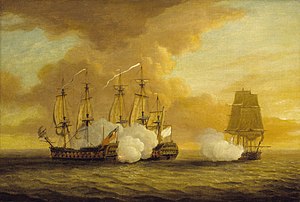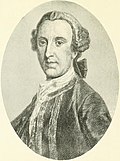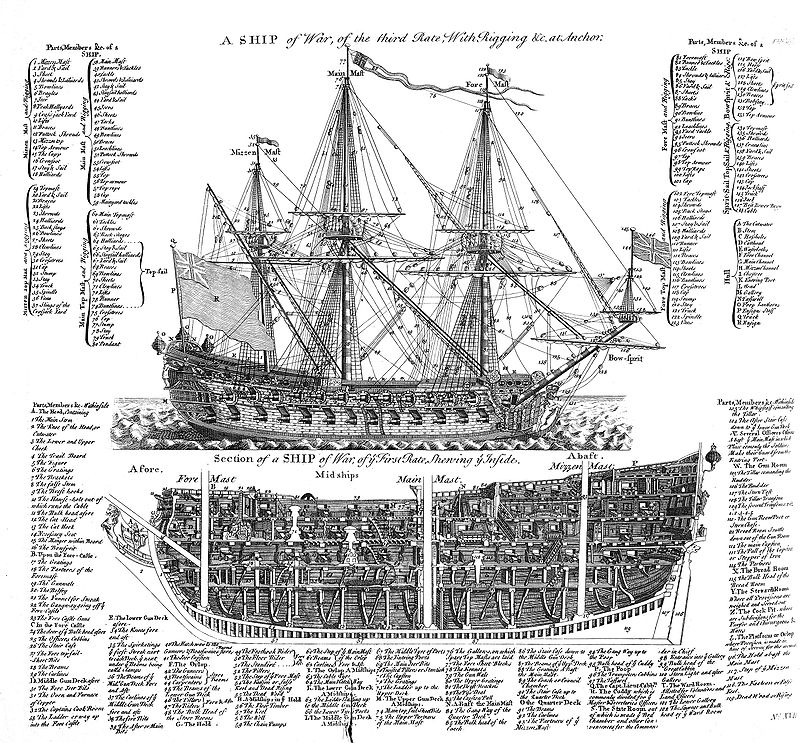HMS Lion (1709)
 HMS Lion attacks two French vessels carrying Prince Charles onboard, 9 July 1745
| |
| History | |
|---|---|
| Name | HMS Lion |
| Builder | Rosewell, Chatham Dockyard |
| Launched | 20 January 1709 |
| Honours and awards | Second Battle of Cape Finisterre, 1747 |
| Fate | Sold, 1765 |
| General characteristics as built[1] | |
| Class and type | fourth rate ship of the line |
| Tons burthen | 914 bm |
| Length | 144 ft (43.9 m) (gundeck) |
| Beam | 38 ft (11.6 m) |
| Depth of hold | 15 ft 8 in (4.8 m) |
| Propulsion | Sails |
| Sail plan | Full-rigged ship |
| Armament |
|
| General characteristics after 1738 rebuild[2] | |
| Class and type | 1733 proposals 60-gun fourth rate ship of the line |
| Tons burthen | 1,068 bm |
| Length | 144 ft (43.9 m) (gundeck) |
| Beam | 41 ft 5 in (12.6 m) |
| Depth of hold | 16 ft 11 in (5.2 m) |
| Propulsion | Sails |
| Sail plan | Full-rigged ship |
| Armament |
|
HMS Lion or Lyon was a 60-gun
Career
On 17 October 1709 Capt. Galfridus Walpole, the youngest son of Sir Robert Walpole, was appointed captain of Lion (50 cannons). He maintained that post till 1714.[3][4]
On 22 March 1711, Lion was with other Royal Navy vessels in Vado Bay on the Italian coast when four French enemy ships were sighted. She and others gave chase and engaged the enemy for about two hours. Forty of Lion's crew were killed, and Walpole was so badly injured that his right arm was amputated by the ship's surgeon John Atkins.[5][6] Walpole's sword from the time of this engagement was subsequently gifted to a young Horatio Nelson and was still in his possession when he too lost his right arm in the Battle of Santa Cruz de Tenerife on 15 July 1797.[7][8]
In September 1712, together with HMS Cornwall, Mary and HMS Superb, assisted Admiral John Jennings with landing troops at Barcelona.[9]
On 9 December 1735 orders were issued for Lion to be dismantled and rebuilt according to the 1733 proposals of the 1719 Establishment at Deptford, from where she was relaunched on 25 April 1738.

During the
Captain Brett, who was wounded in the battle, was obliged to have the captain of the Marines arrested for skulking on the poop under cover of some bags, setting such a bad example that it encouraged most of his men to do likewise.[12] Dominic Serres painted a version of the event in 1860, from three drawings done at the time by Peircy Brett.
In April 1747 Lion was part of a small squadron under the overall command of Thomas Fox on
In January 1748 Charles Watson was appointed commander-in-chief of the Newfoundland and North American station with his flag in HMS Lion.[13]
Lion continued in service until 1765, when she was sold out of the navy.[2]

Notes
- ^ a b Lavery, Ships of the Line vol.1, p168.
- ^ a b Lavery, Ships of the Line vol.1, p171.
- ^ "Galfridus Walpole (d. 1726)". ThreeDecks.org. Retrieved 25 July 2014.
- ^ "Galfridus Walpole appointed Captain". WRECK site. WRECK site. Retrieved 7 December 2016.
- ^ Clowes, William Laird (1898). The Royal Navy, a history from the earliest times to the present. London: Sampson Low, Marston and Company. p. 531.
- ^ Moore, Norman (1885). . In Stephen, Leslie (ed.). Dictionary of National Biography. Vol. 2. London: Smith, Elder & Co.
- ^ Nevill, Lady Corothy (1894). Mannington and the Walpoles (PDF). London: Fine Art Society. pp. 13–14.
- ^ "Florence, September 6th", The London Gazette (5053): 1, 20–23 September 1712
- ^ http://collections.rmg.co.uk/collections/objects/11856.html National Maritime Museum
- ^ Perrin, William Gordon (1928). The Naval Miscellany Vol 63. Google Books: Navy Records Society. pp. 102, 103. Retrieved 7 December 2016.
- ^ "Peircy Brett letter to the Admiralty". 30 July 1745.
{{cite journal}}: Cite journal requires|journal=(help) - doi:10.1093/ref:odnb/28831. Retrieved 8 December 2016. (Subscription or UK public library membershiprequired.)
References
- ISBN 978-1-86176-281-8.
- Lavery, Brian (2003) The Ship of the Line – Volume 1: The development of the battlefleet 1650-1850. Conway Maritime Press. ISBN 0-85177-252-8.
- Michael Phillips. Kent (70) (1746). Michael Phillips' Ships of the Old Navy. Retrieved 9 August 2008.
